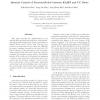Free Online Productivity Tools
i2Speak
i2Symbol
i2OCR
iTex2Img
iWeb2Print
iWeb2Shot
i2Type
iPdf2Split
iPdf2Merge
i2Bopomofo
i2Arabic
i2Style
i2Image
i2PDF
iLatex2Rtf
Sci2ools
ICRA
2002
IEEE
2002
IEEE
Internet Control of Personal Robot between KAIST and UC Davis
This paper describes the implementation of an internet-based personal robot with three control modes, and experimental results on the remote control between KAIST, Korea and UC Davis, USA. The idea is to control a personal robot at the remote site (KAIST) by using a simulator provided at the local site (UC Davis). However, if the information of the current absolute position of the robot at its remote site cannot be estimated, the simulator may be useless. The absolute position of the robot can be determined by comparing a reference map with sensor information from sonar sensors and an electronic compass. A user can use three control modes - direct control mode, supervisory control mode and job scheduling mode, and monitor the current status of the robot using a graphic user interface (GUI) of the simulator implemented with Java.
Control Mode | ICRA 2002 | Personal Robot | Robot | Robotics |
| Added | 15 Jul 2010 |
| Updated | 15 Jul 2010 |
| Type | Conference |
| Year | 2002 |
| Where | ICRA |
| Authors | Kuk-Hyun Han, Yong-Jae Kim, Jong-Hwan Kim, Steve Hsia |
Comments (0)

